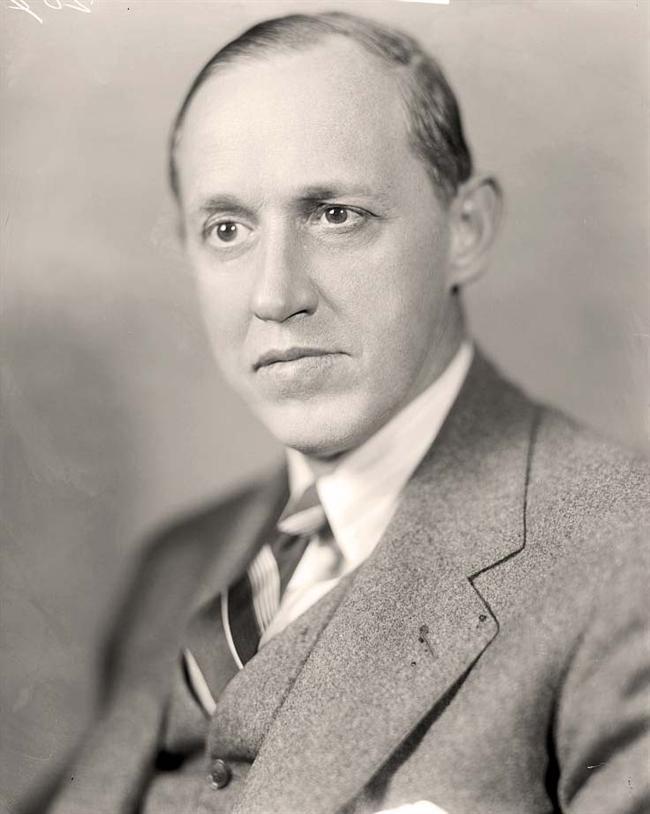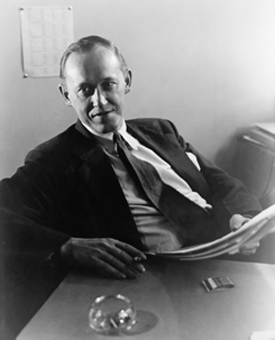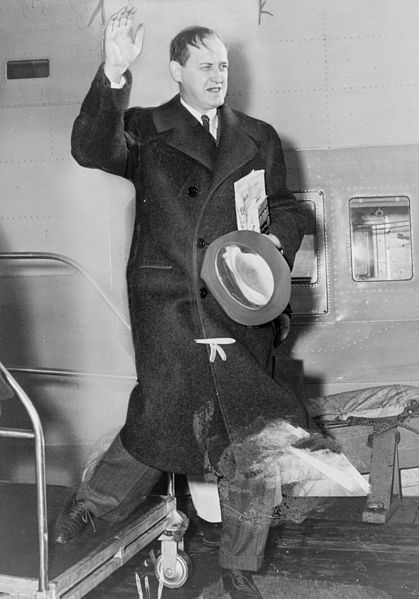<Back to Index>
- 8th United States Secretary of Commerce Harry Lloyd Hopkins, 1890
PAGE SPONSOR



Harry Lloyd Hopkins (August 17, 1890 – January 29, 1946) was one of Franklin Delano Roosevelt's closest advisers. He was one of the architects of the New Deal, especially the relief programs of the Works Progress Administration (WPA), which he directed and built into the largest employer in the country. In World War II he was Roosevelt's chief diplomatic advisor and troubleshooter and was a key policy maker in the $50 billion Lend Lease program that sent aid to the allies.
Harry Hopkins was born at 512 Tenth Street in Sioux City, Iowa, the fourth child of four sons and one daughter of David Aldona and Anna (née Pickett) Hopkins. His father, born in Bangor, Maine, ran a harness shop, after an erratic career as a salesman, prospector, storekeeper and bowling alley operator; but his real passion was bowling, and he eventually returned to it as a business. Anna Hopkins, born in Hamilton, Ontario, had moved at an early age to Vermillion, South Dakota, where she married David. She was deeply religious and active in the affairs of the Methodist church. Shortly after Harry was born, the family moved successively to Council Bluffs, Iowa, and Kearney and Hastings, Nebraska. They spent two years in Chicago, and finally settled in Grinnell, Iowa.
Hopkins attended Grinnell College and soon after his graduation in 1912 took a job with Christodora House, a social settlement in New York City's Lower East Side ghetto. In the spring of 1913 he accepted a position from John A. Kingsbury of the New York Association for Improving the Condition of the Poor (AICP) as "friendly visitor" and superintendent of the Employment Bureau within the AICP's Department of Family Welfare. During the 1915 recession, Hopkins and the AICP's William Matthews, with $5,000 from Elizabeth Milbank Anderson's Milbank Memorial Fund, organized the Bronx Park Employment program, one of the first public employment programs in the U.S..
In 1915, New York City Mayor John Purroy Mitchel appointed Hopkins executive secretary of the Bureau of Child Welfare which administered pensions to mothers with dependent children.
Hopkins at first opposed America's entrance into World War I, but when war was declared in 1917 he supported it enthusiastically. He was rejected for the draft because of a bad eye. Hopkins moved to New Orleans where he worked for the American Red Cross as director of Civilian Relief, Gulf Division. Eventually, the Gulf Division of the Red Cross merged with the Southwestern Division and Hopkins, headquartered now in Atlanta, was appointed general manager in 1921. Hopkins helped draft a charter for the American Association of Social Workers (AASW) and was elected its president in 1923.
In 1922, Hopkins returned to New York City where the AICP was involved with the Milbank Memorial Fund and the State Charities Aid Association in running three health demonstrations in New York State. Hopkins became manager of the Bellevue - Yorkville health project and assistant director of the AICP. In mid 1924 he became executive director of the New York Tuberculosis Association. During his tenure, the agency grew enormously and absorbed the New York Heart Association.
In 1931, New York Governor Franklin D. Roosevelt named R. H. Macy's department store president Jesse Straus as president of the Temporary Emergency Relief Administration (TERA). Straus named Hopkins, then unknown to Roosevelt, as TERA's executive director. His efficient administration of the initial $20 million outlay to the agency gained Roosevelt's attention, and in 1932, he promoted Hopkins to the presidency of the agency. Hopkins and Eleanor Roosevelt began a long friendship, which strengthened his role in relief programs.
In March 1933, Roosevelt summoned Hopkins to Washington as federal relief administrator. Convinced that paid work was psychologically more valuable than cash handouts (the "dole"), Hopkins sought to continue and expand New York State's work - relief programs, the Temporary Emergency Relief Administration. He supervised the Federal Emergency Relief Administration (FERA), the Civil Works Administration (CWA), and the Works Progress Administration (WPA). Over 90% of the people employed by the Hopkins programs were unemployed or on relief. He feuded with Harold Ickes, who ran a rival program — the Public Works Administration — which also created jobs but did not require applicants to be unemployed or on relief.
FERA, the largest program from 1933 to 1935, involved giving money to localities to operate work relief projects to employ those on direct relief. CWA was similar, but did not require workers to be on relief in order to receive a government sponsored job. In less than four months, the CWA hired four million people, and during its five months of operation, the CWA built and repaired 200 swimming pools, 3,700 playgrounds, 40,000 schools, 250,000 miles (400,000 km) of road, and 12 million feet of sewer pipe.
The WPA, which followed the CWA, employed 8.5 million people in its seven year history, working on 1.4 million projects, including the building or repair of 103 golf courses, 1,000 airports, 2,500 hospitals, 2,500 sports stadiums, 3,900 schools, 8,192 parks, 12,800 playgrounds, 124,031 bridges, 125,110 public buildings, and 651,087 miles (1,047,823 km) of highways and roads. The WPA operated on its own, and on selected projects in cooperation with local and state governments, but always with its own staff and budget. Hopkins started programs for youth (National Youth Administration) and for artists and writers (Federal One Programs). He and Eleanor Roosevelt worked together to publicize and defend New Deal relief programs. He was concerned with rural areas but increasingly focused on cities in the Great Depression.
During the war years, Hopkins acted as Roosevelt's unofficial emissary to British Prime Minister Winston Churchill. Roosevelt dispatched Hopkins to assess Britain's determination and situation. Churchill escorted Hopkins all over the United Kingdom, and converted him to the British cause. At a small dinner party before he returned, Hopkins rose to propose a toast. "I suppose you wish to know what I am going to say to President Roosevelt on my return. Well I am going to quote to you one verse from the Book of Books ... "Whither thou goest, I will go and where thou lodgest I will lodge, thy people shall be my people, and thy God my God." Hopkins became the administrator of Lend Lease.
Hopkins had a major voice in policy for the vast $50 billion Lend Lease program, especially regarding supplies, first for Britain and then (upon the German invasion) the USSR. He went to Moscow in July 1941 to make personal contact with Joseph Stalin. Hopkins recommended, and the president accepted, the inclusion of the Soviets in Lend Lease. He then accompanied Churchill to the Atlantic Conference. Hopkins promoted an aggressive war against Germany and successfully urged Roosevelt to use the Navy to protect convoys before the U.S. entered the war in December 1941. Roosevelt brought him along as advisor to his meetings with Churchill at Cairo, Tehran, Casablanca in 1942 - 43, and Yalta in 1945. He was a firm supporter of China, which received Lend Lease aid for its military and air force. Hopkins wielded more diplomatic power than the entire State Department. Hopkins helped identify and sponsor numerous potential leaders, including Dwight D. Eisenhower. He continued to live in the White House and saw the president more often than any other advisor.
Although Hopkins' health was steadily declining, Roosevelt sent him on additional trips to Europe in 1945; he attended the Yalta Conference in February 1945. He tried to resign after Roosevelt died, but President Harry S. Truman sent him on one more mission to Moscow. American Ambassador to Moscow Averell Harriman reported to a class at George Washington University in the Fall of 1992 that it was in 1945 that he observed how Stalin once abruptly terminated a conversation and proceeded to cross the span of a large hall at the Kremlin to personally greet Hopkins as he and Harriman entered. Harriman indicated that this was considered by all those present to be a strong indication of the Soviet view of the respect that the Soviets had for Hopkins personally, that such a breech of protocol was signaling a great honor.
Hopkins had 3 sons who served in the armed forces during the war, Robert, David and Stephen. Stephen was killed in action serving in the United States Marine Corps, during the landing on Kwajalein Atoll in the Pacific Theater.
Hopkins was the top American official charged with dealing with Soviet officials during World War II and spoke with many Russians, from middle ranks to the very highest. He often explained to Stalin and other top Soviets what Roosevelt was planning, in order to enlist Soviet support for American objectives. As a major decision maker in Lend Lease, he expedited the sending of material to the Soviet Union, as Congress had ordered, in order to end the war as quickly as possible. This included accepted shipments of uranium and offered shipments of "ferro - uranium from Latrobe". George Racey Jordan, a lend - lease major in the Air Force, accused Hopkins of passing nuclear weapons plans to the USSR, but a congressional committee stated the charges were dubious.
It is likely that Soviets who spoke to Hopkins would have been routinely required to report the contact to the NKVD, the Soviet national security agency. Mark (1998) says that some Soviets such as master spy Iskhak Akhmerov thought he was pro - Soviet while others thought he was not. Verne W. Newton, author of FDR and the Holocaust, said that no writer discussing Hopkins has identified any secrets disclosed, or any decision in which he distorted American priorities in order to help Communism. As Mark demonstrates, Hopkins was not in fact pro - Soviet in his recommendations to FDR, he was anti - German and pro - U.S. Any "secrets" disclosed were authorized. Mark says that at this time any actions were taken specifically in order to help the American war effort and prevent the Soviets from making a deal with Hitler.
Hopkins died in New York City in January 1946, succumbing to a long and debilitating battle with stomach cancer. His body was cremated and the ashes interred in his old hometown of Grinnell, Iowa.
There is a house on the Grinnell College campus named after him.